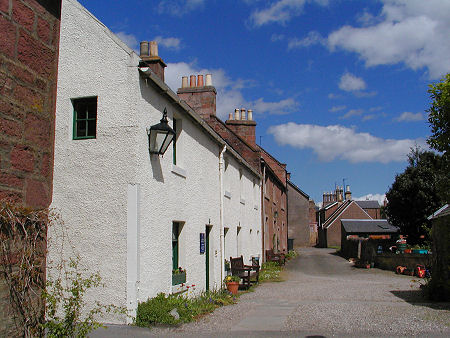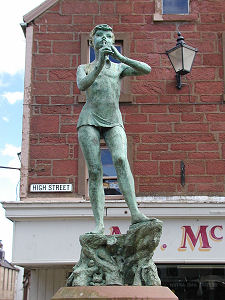
J.M. Barrie's Birthplace in
Kirriemuir
|
Sir James Matthew Barrie, 1st Baronet, OM, to give him his full
range of
titles, was born the ninth of ten children to a weaving family in a
house in Kirriemuir
now preserved by the National Trust for Scotland as a museum. When
James was
six, his 13 year old brother David died in a skating accident on the
eve of his
14th birthday. David had been their mother's favourite and she never
recovered
from the loss, repeatedly confusing James with David and effectively
denying
him a separate identity. Meanwhile, the father refused to have any
dealings with
the children at all. As a result of what would today be considered
psychological abuse, James suffered from psychogenic dwarfism and never
grew
beyond 4'10" in height.
Barrie went to school in Kirriemuir
and Forfar, before moving to Glasgow
and then Dumfries
with his elder brother Alexander. He went on to study at Edinburgh
University. From an early age Barrie had a keen
interest in
writing, producing material for school magazines and drama groups, and
while in
Edinburgh
he had articles published in local newspapers. He also met Sir
Arthur Conan Doyle and Robert
Louis Stevenson.
After graduating, Barrie worked for a while at the Nottingham Journal, until cutbacks led to
his
redundancy. Back in Kirriemuir
he embarked on a successful series of stories based on tales from the
town and
surrounding area, but set in a fictional "Thrums". In 1885 Barrie
moved to London, making an increasingly good living from newspaper
articles,
novels, and later from scripts for the theatre. He even co-authored,
with Sir
Arthur Conan Doyle, an opera called Jane Annie, or The Good Conduct Prize. It
flopped
when first performed at the Savoy Theatre in 1893, and has rarely been
seen
since.
But it was one work in particular, and one character in particular,
that
was to ensure J.M. Barrie's lasting fame, though the story of its
emergence is
a complex one. In 1894, Barrie married an actress, Mary Ansell. It
would seem
that the most successful product of their marriage was the St Bernard
puppy
they bought while on honeymoon in Switzerland. It was through walking
the dog
near his home in London in 1897 or 1898, that Barrie came to meet and
know the
Llewelyn-Davies family, Arthur and Sylvia and their five sons.
Over time, Barrie grew closer to the family, and more distant from
his
wife. Out of the stories he invented to entertain the Llewelyn-Davies
boys
emerged the character of Peter Pan, the boy who never grew up. Peter
Pan first
appeared in print in 1901 in The
Little White Bird. This was followed by the stage play
Peter Pan, which
had its
first performance on 27 December 1904, and which itself was later
produced in
novel form.
Barrie's fame expanded as his fortune grew. He was knighted in
1913, the
year in which he also became Rector of St
Andrews University. He received the Order of Merit in
1922;
in 1928 he succeeded Thomas Hardy as President of the Society of
Authors; and
he was Chancellor of the University
of Edinburgh from 1930 to 1937, the year in which he
died.
But his private life was less successful. Barrie's marriage was
dissolved
in 1910, the same year in which Sylvia Llewelyn-Davies died (her
husband had
died three years earlier). Barrie adopted their five sons, the "lost
boys", but one was killed during the First World War and another drowned
in 1921.
Over the years at least three different theories have developed
about who
was represented by Peter Pan. Barrie himself said that the character
was a
composite of the five Llewelyn-Davies boys: and the youngest, Peter
Llewelyn-Davies, lent the character part of his name. Peter Llewelyn-
Davies
never fully came to terms with his association with Peter Pan, nor did
he
overcome the disappointment at being left out of Barrie's will. On 5
April 1960
he threw himself under a train in London. But many have suggested two
other
points of origin for the "boy who wouldn't grow up". One, obviously,
was J.M. Barrie himself, who literally didn't grow up because of the
stress he
was subjected to as a child. The other was his brother David, who
having died
at the age of 13 would forever remain a child. Or perhaps Barrie just
drew all
these different elements together in creating Peter Pan.
Barrie's memory is kept alive today by a statue of Peter Pan in
Kensington
Gardens, London, and another in the centre of his home town, Kirriemuir,
where he is also buried: while the house in which he was born has been
preserved as a museum by the National Trust for Scotland. Before Barrie
died,
he gifted the copyright of the stage play to Great Ormond Street
Hospital, so
every time the play is performed, the hospital benefits.
©
2000-2008 Undiscovered Scotlan© http://www.undiscoveredscotland.co.uk/usbiography/abc/jmbarrie.html
© 2000-2008 Undiscovered
Scotland
OTHER INTERESTING BIOGRAPHIES: Next [1] [2] [3] [4] [5] [6] [7] [8]

